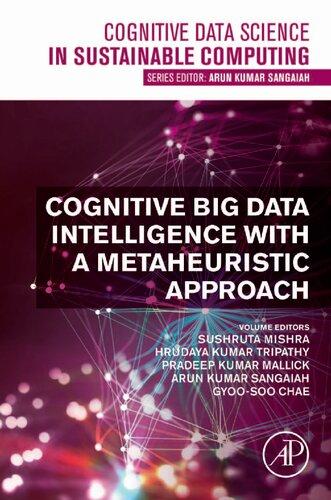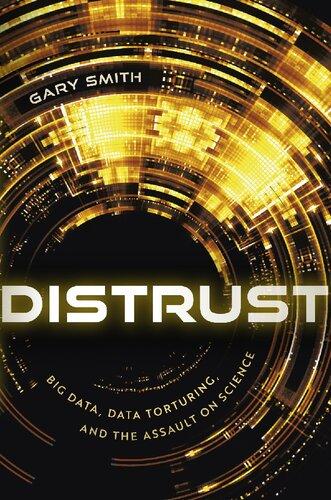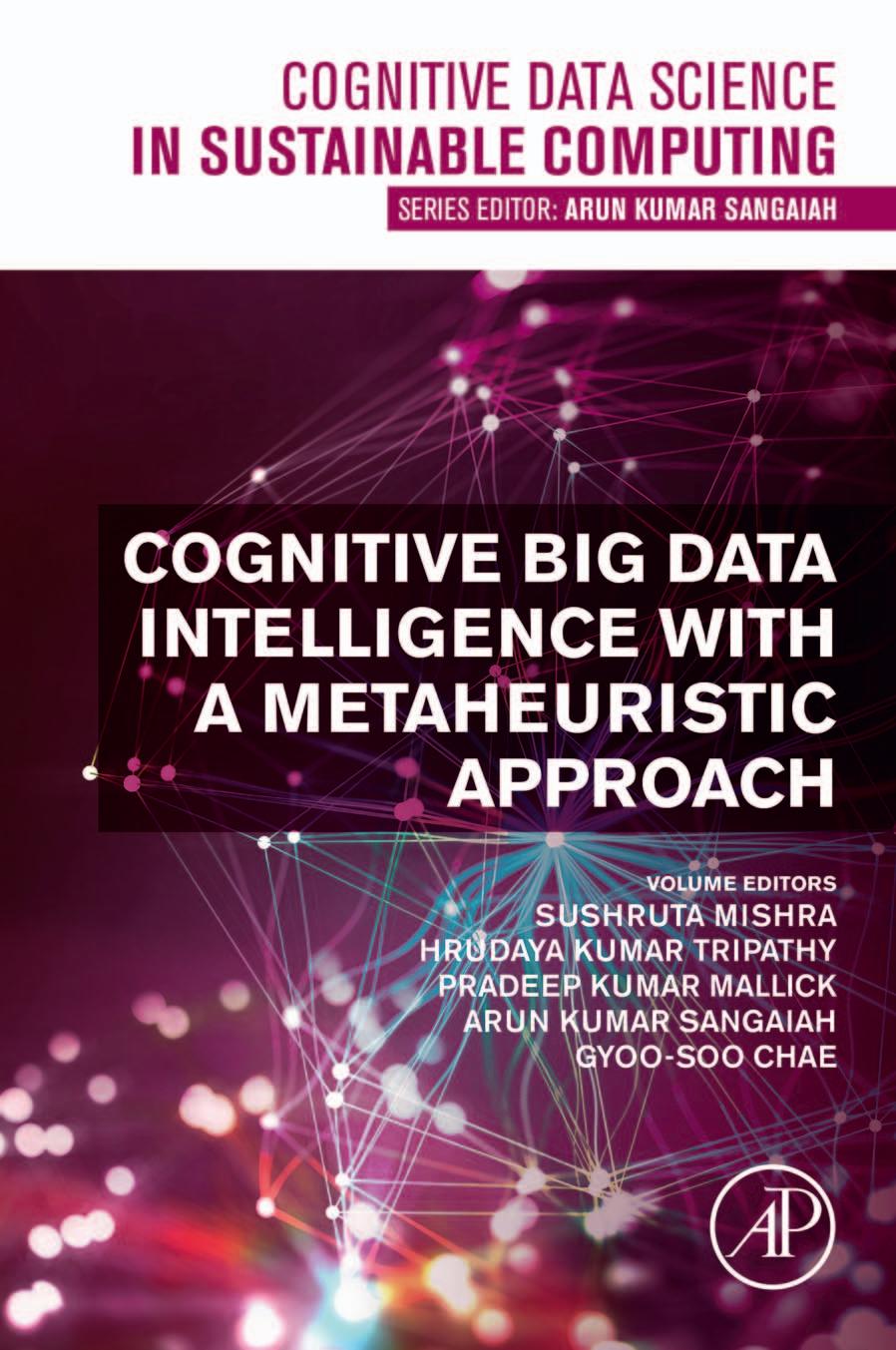CognitiveBigData Intelligencewitha Metaheuristic Approach
SeriesEditor
ArunKumarSangaiah
VolumeEditors
SushrutaMishra
SchoolofComputerEngineering,KalingaInstituteofIndustrialtechnology (KIIT)University,Bhubaneswar,Odisha,India
HrudayaKumarTripathy
SchoolofComputerEngineering,KalingaInstituteofIndustrialtechnology (KIIT)University,Bhubaneswar,Odisha,India
PradeepKumarMallick
SchoolofComputerEngineering,KalingaInstituteofIndustrialtechnology (KIIT)University,Bhubaneswar,Odisha,India
ArunKumarSangaiah
SchoolofComputerScience,TheUniversityofAdelaide,Adelaide,SA, Australia
Gyoo-SooChae
DivisionofICT,BaekseokUniversity,Cheonan,SouthKorea
AcademicPressisanimprintofElsevier
125LondonWall,LondonEC2Y5AS,UnitedKingdom 525BStreet,Suite1650,SanDiego,CA92101,UnitedStates 50HampshireStreet,5thFloor,Cambridge,MA02139,UnitedStates TheBoulevard,LangfordLane,Kidlington,OxfordOX51GB,UnitedKingdom
Copyright 2022ElsevierInc.Allrightsreserved.
Nopartofthispublicationmaybereproducedortransmittedinanyformorbyanymeans, electronicormechanical,includingphotocopying,recording,oranyinformationstorage andretrievalsystem,withoutpermissioninwritingfromthepublisher.Detailsonhowto seekpermission,furtherinformationaboutthePublisher’spermissionspoliciesandour arrangementswithorganizationssuchastheCopyrightClearanceCenterandtheCopyright LicensingAgency,canbefoundatourwebsite: www.elsevier.com/permissions .
Thisbookandtheindividualcontributionscontainedinitareprotectedundercopyrightby thePublisher(otherthanasmaybenotedherein).
Notices
Knowledgeandbestpracticeinthis fieldareconstantlychanging.Asnewresearchand experiencebroadenourunderstanding,changesinresearchmethods,professional practices,ormedicaltreatmentmaybecomenecessary.
Practitionersandresearchersmustalwaysrelyontheirownexperienceandknowledgein evaluatingandusinganyinformation,methods,compounds,orexperimentsdescribed herein.Inusingsuchinformationormethodstheyshouldbemindfuloftheirownsafety andthesafetyofothers,includingpartiesforwhomtheyhaveaprofessionalresponsibility.
Tothefullestextentofthelaw,neitherthePublishernortheauthors,contributors,or editors,assumeanyliabilityforanyinjuryand/ordamagetopersonsorpropertyasamatter ofproductsliability,negligenceorotherwise,orfromanyuseoroperationofanymethods, products,instructions,orideascontainedinthematerialherein.
LibraryofCongressCataloging-in-PublicationData
AcatalogrecordforthisbookisavailablefromtheLibraryofCongress
BritishLibraryCataloguing-in-PublicationData
AcataloguerecordforthisbookisavailablefromtheBritishLibrary
ISBN:978-0-323-85117-6
ForinformationonallAcademicPresspublicationsvisitour websiteat https://www.elsevier.com/books-and-journals
Publisher: MaraConner
AcquisitionsEditor: SonniniR.Yura
EditorialProjectManager: MichelleFisher
ProductionProjectManager: SreejithViswanathan
CoverDesigner: ChristianJ.Bilbow
TypesetbyTNQTechnologies
Contributorsxiii
Prefacexv
1. Adiscourseonmetaheuristicstechniquesforsolving clusteringandsemisupervisedlearningmodels 1
NishantKashyapandAnjanaMishra
1.Introduction 1
2.Overviewofclustering 2
2.1K-meansclustering2
2.2Hierarchicalclustering2
2.3FuzzyC-means2
2.4Model-basedclustering4
2.5Particleswarmoptimization4
2.6ClusteringusingPSO6
2.7Antcolonyoptimization7
2.8ClusteringusingACO9
2.9Geneticalgorithm10
2.10Differentialevolution13
2.11Clusteringusingdifferentialevolution14
2.12Semisupervisedlearningalgorithms15
2.13PSO-assistedsemisupervisedclustering15
2.14SemisupervisedclusteringusingGA17
3.Conclusion 18 References 18
2. Metaheuristicsinclassification,clustering,and frequentpatternmining 21
HirenKumarThakkar,HrushikeshShuklaand PrasanKumarSahoo
1.Introduction 21
1.1Introductiontometaheuristics21
1.2Classificationofmetaheuristictechniques22
1.3Workingofsomemetaheuristicalgorithms24
2.Metaheuristicsinclassification 29
2.1Useofantcolonyoptimizationinclassification30
2.2Useofgeneticalgorithmsinclassification33
2.3Useofparticleswarmoptimizationinclassification37
3.Metaheuristicsinclustering 40
3.1Useofantcolonyoptimizationinclustering41
3.2Useofgeneticalgorithmsinclustering45
3.3Useofparticleswarmoptimizationinclustering49
4.Metaheuristicsinfrequentpatternmining 54
4.1Useofantcolonyoptimizationinfrequentpatternmining54
4.2Useofgeneticalgorithmsinfrequentpatternmining58
4.3Useofparticleswarmoptimizationinfrequent patternmining61
5.Conclusion 67 References 67
3. Impactsofmetaheuristicandswarmintelligence approachinoptimization 71
AbhishekBanerjee,DharmpalSingh,SudiptaSahanaand IraNath
1.Introduction 71
1.1Introductionofmetaheuristic71
1.2Introductionofswarmintelligence73
2.ConceptsofMetaheuristic 73
2.1Optimizationproblems73
2.2Classificationofmetaheuristictechniques74
2.3Agenericmetaheuristicframework76
3.Metaheuristictechniques 76
3.1Simulatedannealing77
3.2Geneticalgorithms77
3.3Antcolonyoptimization78
3.4BeeAlgorithms78
3.5Particleswarmoptimization78
3.6Harmonysearch79
3.7Tabusearch79
4.Swarmintelligencetechniques 80
4.1BatAlgorithm80
4.2Fireflyalgorithm82
4.3LionOptimizationAlgorithm85
4.4Chickenswarmoptimizationalgorithm85
4.5SocialSpiderAlgorithm86
4.6Spidermonkeyoptimizationalgorithm88
4.7Africanbuffalooptimizationalgorithm90
4.8Flowerpollinationalgorithm91
6. Inertiaweightstrategiesfortaskallocationusing metaheuristicalgorithm
ArabindaPradhanandSukantKishoroBisoy
7. BigdataclassificationwithIoT-basedapplication fore-healthcare
SaumendraKumarMohapatraandMihirNarayanMohanty
6.Multiagentsystemforbiomedicaldataprocessing
8. Studyofbio-inspiredneuralnetworksforthe predictionofliquidflowinaprocesscontrolsystem
PijushDutta,KorhanCengizandAsokKumar
4.1Preliminarydetailsoftheneuralnetwork(NN)177
4.2Preliminariesofthefireflyalgorithm179
4.3Preliminariesofparticleswarmoptimization(PSO)180
5.Proposedmodel 180
5.1Modelingoftheflowrateusinganeuralnetwork180
Contents
11. CognitivebigdataanalysisforE-healthand telemedicineusingmetaheuristicalgorithms
DeepakRaiandHirenKumarThakkar 1.Introduction
1.1WhyE-healthcare?240 1.2AdvantagesofE-healthcare242
2.CognitivecomputingtechnologiesforE-healthcare
3.CognitivebigdataanalyticsforE-healthcare
3.1RoleofHadoopandApacheSparkinE-health careanalytics245
4.NeedforcognitivebigdataanalyticsinE-healthcare
5.AdvantagesofcognitivebigdataanalyticsinE-healthcare
6.ChallengesofcognitivebigdataanalyticsinE-healthcare
7.Metaheuristicapproachforoptimizationofcognitivebig datahealthcare
7.1Benefitsofmetaheuristicapproachoverclassical optimizationmethods250
7.2Applicationsofmetaheuristicsincognitivebig data basedhealthcare251
8.CognitivebigdataanalyticsusecasesinE-healthcare
12. Multicriteriarecommendersystemusingdifferent approaches
ChandramouliDas,AbhayaKumarSahooand ChittaranjanPradhan 1.Introduction
3.1Modelingphase264
3.2Predictionphase264
3.3Recommendationphase264
3.4Content-basedapproach264
3.5Collaborativefilteringapproach265
3.6Knowledge-basedfilteringapproach266
Contributors
AngeliaMelaniAdrian,InformaticsEngineeringDepartment,DeLaSalleCatholic University,ManadoCity,Indonesia
AbhishekBanerjee,PailanCollegeofManagementandTechnology,Pailan,Joka, Kolkata,WestBengal,India
AradhanaBehura,DepartmentofComputerScience&Engineering,VeerSurendra SaiUniversityofTechnology,Burla,Odisha,India
SukantKishoroBisoy,DepartmentofComputerScienceandEngineering,C.V. RamanGlobalUniversity,Bhubaneswar,Odisha,India
KorhanCengiz,DepartmentofTelecommunication,TrakyaUniversity,Edirne,Turkey
ChandramouliDas,SchoolofComputerEngineering,KIITDeemedtobeUniversity, Bhubaneswar,Odisha,India
AnkitDesai,Embibe,Bengaluru,Karnataka,India
PijushDutta,DepartmentofElectronicsandCommunicationEngineering,Global InstituteofManagementandTechnology,Krishnagar,WestBengal,India
PriyomDutta,SchoolofComputerEngineering,KIITUniversity,Bhubaneswar, Odisha,India
ManasRanjanKabat,DepartmentofComputerScience&Engineering,Veer SurendraSaiUniversityofTechnology,Burla,Odisha,India
NishantKashyap,C.V.RamanGlobalUniversity,Bhubaneswar,Odisha,India
AsokKumar,DeanofStudentWelfareDepartment,VidyasagarUniversity,Medinipur, WestBengal,India
B.S.Mahanand,DepartmentofInformationScienceandEngineering,SriJayachamarajendraCollegeofEngineering,JSSScienceandTechnologyUniversity, Mysuru,Karnataka,India
AnjanaMishra,C.V.RamanGlobalUniversity,Bhubaneswar,Odisha,India
SushrutaMishra,KalingaInstituteofIndustrialTechnologyDeemedtobeUniversity, Bhubaneswar,Odisha,India
RickyMohanty,DepartmentofElectronics&Telecommunication,OrissaEngineering College,Bhubaneswar,Odisha,India
MihirNarayanMohanty,ITER,Siksha‘O’Anusandhan(DeemedtobeUniversity), Bhubaneswar,Odisha,India
SaumendraKumarMohapatra,ITER,Siksha‘O’Anusandhan(Deemedtobe University),Bhubaneswar,Odisha,India
IraNath,JISCollegeofEngineering,Kalyani,WestBengal,India
SubhenduKumarPani,KrupajalComputerAcademy,Bhubaneswar,Odisha,India
MoushitaPatnaik,SchoolofComputerEngineering,KIITUniversity,Bhubaneswar, Odisha,India
ArabindaPradhan,DepartmentofComputerScienceandEngineering,C.V.Raman GlobalUniversity,Bhubaneswar,Odisha,India
ChittaranjanPradhan,SchoolofComputerEngineering,KIITDeemedtobe University,Bhubaneswar,Odisha,India
RojanlinaPriyadarshini,DepartmentofComputerScienceandInformationTechnology,C.V.RamanGlobalUniversity,Bhubaneswar,Odisha,India
DeepakRai,DepartmentofComputerScienceandEngineering,NationalInstituteof Technology,Patna,Bihar,India
PriyankaRay,KalingaInstituteofIndustrialTechnologyDeemedtobeUniversity, Bhubaneswar,Odisha,India
VaisnavRoy,SchoolofComputerEngineering,KIITUniversity,Bhubaneswar, Odisha,India
SudiptaSahana,JISCollegeofEngineering,Kalyani,WestBengal,India
AbhayaKumarSahoo,SchoolofComputerEngineering,KIITDeemedtobe University,Bhubaneswar,Odisha,India
PrasanKumarSahoo,DepartmentofComputerScienceandInformationEngineering,ChangGungUniversity,TaoyuanCity,Taiwan
QusaySellat,DepartmentofComputerScienceandEngineering,C.V.RamanGlobal University,Bhubaneswar,Odisha,India
HrushikeshShukla,SchoolofComputerScienceandEngineering,Dr.Vishwanath KaradMITWorldPeaceUniversity,Pune,Maharashtra,India
DharmpalSingh,JISCollegeofEngineering,Kalyani,WestBengal,India
HirenKumarThakkar,DepartmentofComputerScienceandEngineering, Schoolof EngineeringandSciences, SRMUniversity,Mangalagiri,AndhraPradesh,India
Preface
Inrecenttimes,informationindustryhasexperiencedrapidchangesinboth theplatformscaleandscopeofapplications.Computers,smartphones,clouds, socialnetworks,andsupercomputersdemandnotonlyhighperformancebutalso ahighdegreeofmachineintelligence.Atpresent,Bigdataisplayingasignificantroleinthefieldofinformationtechnologyand,morespecifically,inthe DataSciencedomain.Manysolutionsarebeingofferedinaddressingbigdata analytics.Analysisofdatabyhumanscanbeatime-consumingactivity,and thus,theuseofsophisticatedcognitivesystemscanbeutilizedtocrunchthis enormousamountofdata.Cognitivecomputingcanbeutilizedtoreducethe shortcomingsoftheconcernsfacedduringbigdataanalytics.Thus,weare enteringaneraofbigdataandcognitivecomputing.Tomeetthesenew computingandcommunicationchanges,wemustupgradethecloudsandthe computingecosystemwithnewcapabilities,suchasmachinelearning,IoT sensing,dataanalytics,andcognitivemachinesmimickinghumanintelligence. Metaheuristicalgorithmshaveproventobeeffective,robust,andefficientin solvingreal-worldoptimization,clustering,forecasting,classification,andother engineeringproblems.Theabilityofmetaheuristicsalgorithmsincludesmanagingasetofsolutions,attendingmultipleobjectives,aswellastheirability tooptimizevariousvalues,whichallowsthemtofitindealingwithbigdata analytics.Metaheuristicalgorithmshavebecomepowerfulandfamousin computationalintelligenceandmanyapplications.Thisvolumeintendsto projectdifferentframeworksandapplicationsofcognitivebigdataanalytics usingthemetaheuristicsapproach.
Thisbookisdesignedasaself-containededitionsothatreaderscanunderstanddifferentaspectsofrecentinnovationsofmetaheuristicstoknowledge discoveryproblemsinthecontextofBigDataandCognitivecomputing.As manyas15chaptersaremadeaspartofthisbook.Differentapplicationdomains relatedtothescopeofthisbookarediscussedwhichincludemetaheuristicsin clusteringandclassification,swarmintelligence,heuristicsinvirtualreality, deeplearning,andbigdatawithIoTandrecommendationsystemamongothers.
Adiscourseonmetaheuristics techniquesforsolving clusteringandsemisupervised learningmodels
NishantKashyap,AnjanaMishra C.V.RamanGlobalUniversity,Bhubaneswar,Odisha,India
1.Introduction
Arapidsurgeofmachinelearningalgorithmshavebeenseeninthelastdecade whichhasalsopointedouttheneedforstate-of-theartoptimizationtechniques todealwiththelargeamountofdatainvolved.Metaheuristicsinvolvingdatadrivenmethodshaveshowntheireffectivenessinbetterqualityofsolutions andbetterconvergencerate.
Metaheuristicsmethodsexplorethesolutionspacetofindgloballyoptimumsolutionandimproveuponthegeneralsearchingprocedureprovidedby theheuristicmethods.Theyguideabasicandsimpleheuristicmethodby inculcatingvariousconceptstoexploitthesearchspaceofthegivenproblem [1].Metaheuristicstechniquesaregenerallynondeterministicandapproximate butgivegoodenoughsolutioninreasonabletime.Besides,thesemethodsare particularlywellsuitedtosolvingnonconvexoptimizationproblemsincluding thelikesofthoseencounteredduringclustering.Awiderangeofmetaheuristicshavebeendiscoveredrangingfromsearch-basedmethodslike simulatedannealingandtabusearchtothepopularnatureinspiredandthe evolutionaryalgorithms.Abriefdiscussiononthewidelyusedmetaheuristics isdiscussedinourstudy.
Clusteringandsemisupervisedmethodsareahottopictoday,findingits usesinmultipleimportantfieldsrangingfrombigdata,wirelesssensornetworkstobioinformaticstonameafew[2].Assuch,ithasbecomeoneofthe mostsoughtafterareasinresearchtoimprovetheperformanceoftheexisting methodsinvolved.Mostofthealgorithmsusedforclusteringandclassification sufferfromdrawbacksrelatedtobeingtrappedinthelocalmaximaorminima.
2 CognitiveBigDataIntelligencewithaMetaheuristicApproach
Duetothis,weusevariousnature-inspiredmetaheuristictechniquestofind globallyoptimalsolutionsinreasonableamountofcomputationtime. Beforestartingoutwiththemetaheuristics,westartoutwithanoverview ofthestandardmethodsforclustering.
2.Overviewofclustering
2.1K-meansclustering
Clusteringusingk-meansbasicallyculminatestoassigningthedatavectors, Zp accuratelytokclusters.Basically,theaimistominimizethesumofthe squarederrors,i.e., P k j¼1" P forallWp ε clusterki Wp ki 2 # byrepeatingthe followingstepsforsomenumberofiteration(ortillsometerminationconditionisreached):
1. Randomlyinitializetheclustercentroids.Then,foreachdatavectorZp, assignittheclusterwithcentroidski(i ¼ 1,2,3, .,k)suchthat||Zp ki||is minimum(here,||x||representstheEuclideannormofx)
2. Foreachcluster,findathenewclustercentroid,Ki suchthat Ki ¼ 1 jki j P forallWp ε clusterki Wp (where|ki|isthenumberofdatavectorsin clusterki)
2.2Hierarchicalclustering
Inhierarchicalclustering,therequirednumberofclustersisformedina hierarchicalmanner.Forsomennumberofdatapoints,initiallyweassign eachdatapointtonclusters,i.e.,eachpointinaclusterinitself.Thereafter,we mergetwopointswiththeleastdistancebetweenthemintoasinglecluster. Thedistanceoftheotherpointsfromthisclustermadeoftwopointsisthe leastdistancefromeitherofthetwopointsfromtheotherpoints.Thisprocess iscontinueduntilwegettherequirednumberofclusters(Fig.1.1).
2.3FuzzyC-means
Thisisusedwhenthedatapointsarefuzzy,i.e.,theycanbelongtotwoor moreclustersatthesametime.Eachdatapoint(therebeingndatapoints) belongstosomeclusterwithsomeweight(Fig.1.2).
Gij whereGij denotesbelongingness(weight)theithdatapointtothejth clustercj (withcentroidskj).Itisimportanttonotethatallweightsofadata pointaddupto1asshowninRef.[3].Infuzzyc-means,thesquarederror functionthatwewanttominimizeis Eq.(1.1)
Hierarchicalclustering,closestpointsclusteredfirst.
Here,dissomevaluefrom1toinfinitywhichisusedtocontroltheweights. Atfirstallthevaluesoftheweightsareinitialized.Thereafter,the followingstepsarerepeatedtillsometerminationcondition:
I. Calculatetheclustercentroids.
II. Updatetheweights.
Theclustercentroidsareupdatedasfollows:
Andtheweightsareupdatedasfollows:
FIGURE1.1
FIGURE1.2 Clusteringonfuzzysets.
2.4Model-basedclustering
Thisformofclusteringisbasedonprobabilisticdistribution.Somemodelsare usedtoclusterthedataandthentherelationbetweenthedatapointsandthe modelisoptimized.Generally,Gaussiandistributionisusedforcontinuous pointsandPoissonfordiscreetpoints.Inthisregard,theEMalgorithmis widelyusedtofindthemixtureofGaussians[4].Forothermodels,referto Ref.[5].
2.5Particleswarmoptimization
Theparticleswarmoptimization(PSO)isaswarm-basedoptimizationtechniquewhichdrawsinspirationfromtheforagingbehaviorofswarmsofbirds orthatoffishschooling.Thisoptimizationtechniqueisquiteusefulwhen continuousnonlinearfunctionsareinvolved[6].
Letusindulgeourselvesinascenariowhichdepictstheintuitionbehind techniqueinregardtothebehaviorofforagingswarms.Supposethereisa swarmofbirdforagingforfoodwhichislimitedandisconcentratedina particularlocation.Anaı¨vestrategytoreachthelocationisthat(Fig.1.3)each andeverybirdsearchestheentirearea(searchspace);however,thismightlead tosomebirdsneverreachingthelocationduetorandomnatureofthesearchor somereachingsolatethattheresourceisalreadydepleted.Instead,whatthe birdsdoisthateachofthemconsidersthebestposition(positionofthebird whichisclosesttothefoodsource)amongallthebirdsandkeepsamemoryof theirpreviousbestposition(theirclosestindividualpositionfromthefood source)toupdatetheirpositionandvelocity.Thisconnectionamongstthe birdsandthefactthatthebestwaytosearchistofollowthebirdwhoisclosest tothesourceformthebasisofthetechnique[7].

WhiledealingwithanumericoptimizationproblemusingPSO,initially therecanbelotofsolutions.Eachsolutionisdenotedasaparticleandeachis particleisassociatedwithapositionandvelocityateachturnofupdation[8]. Besides,eachparticlekeepstrackofitsbestpositionPbest (whereitwasclosest totheglobaloptimum)andthatoftheglobalbest[9],Gbest (positionofthe particleclosesttotheglobaloptimum).Thevelocityandpositionequationare givenasfollows:
{positionshouldbevelocity*time,butsinceupdationisdoneoverasingle turntimecanbethoughtas1}
Here,V(t)isthevelocityassociatedwiththeparticleattimet. X(t)isthepositionoftheparticleattimet r1, r2 arerandomvaluesrangingfrom0to1 c1 isaconstantcalledthecognitive(localorpersonal)weight c2 isaconstantcalledthesocial(orglobal)weight. Wisaconstantfactorcalledtheinertiaweight. Letusconsiderafunctiontounderstandtheworkingsbetter.Supposewe havetofindtheglobalminimaof
Now,althoughitisapparentthattheplotwillhaveaminimaat(x,y) ¼ (0,0) withavalueof0,nonetheless,wecanseetheconvergenceofthePSOquite wellhere.Letusstartatapoint(x,y) ¼ (37.5,18.75).Here,F(x)willbe1832.81. LetV(t)be( 1, 2),Wbe0.6,c1 andc2 be1.4,andr1, r2 be0.4and0.5, respectively.LetthePbest be(31.25,12.5)yieldingavalue1195.31andtheGbest be(12.5,18.75)yieldingavalue532.81(Fig.1.4).
FIGURE1.4 Plotofthefunction.
FðXÞ¼ X2 þ Y2 þ 2X
Nowputtingtheabovevalues,weget
Vðt þ 1Þ¼ f0 6 ð 1; 2Þgþ f1.4 0 4 ð31.25; 12.5Þ ð37.5; 18.750Þg þ f1.4 0:5 ð12.5; 18.75Þ ð37.5; 18.75Þg
¼ð 0.6; 1.2Þþð 3.5; 3.5Þþð 17.5; 0Þ
¼ð 21.6; 4.7Þ
Xðt þ 1Þ¼ð37.5; 18.75Þþð 21.6; 4.7Þ
¼ð15.9; 14.05Þ whichisclosertotheoptimalpoint(0,0).
2.6ClusteringusingPSO
Inaclusteringproblem,letWp representadatavector,kbethenumberof clusters,andki bethenumberofparticlesinclusteri.
Eachparticlecanbethoughtofasasetofkclustercentroids,i.e.,theith particleisdeterminedasfollows:
Xi ¼ fmi1 ; mi2 ; ; mik g
wheremij isthejthclustercentroidoftheithparticle.Unlessstatedotherwise, wewillbeusingtheaforementionedsymbolsthroughoutthechapter.
ThePSOequationfortheithparticlecanbethenwrittenasfollows:
Ingeneral,lowertheintraclusterdistance(thedistancebetweenallthedata vectorsandthecentroidinaparticularcluster),bettertheresultsare. Henceforth,wecandefinethequantizationerrorforaparticleiastheaverage intraclustererroras
ClusteringusingPSOrunsonthefollowingalgorithm:
❖ Initially,eachandeveryparticleisrandomlyinitialized,i.e.,allthekcluster centroidsoftheparticlearerandomlyinitializedandsomevelocityassociatedwiththem.
❖ Forsomenumberofiterationt,wedothefollowing: n Foreachparticlei:
➢ FordatavectorWp, wefirstcalculate||Wp Cij||(Euclideannorm)toall theclustercentroidsofparticleiandthenassigneachdatavectortothe
clustercentroidswithwhichithastheleastEuclideannormamongall theclustercentroids.
➢ Then,thefitnessfortheparticleiscalculatedusingthefitnessequation. n TheGbesst andPbest arethenchangedaccordinglyafterwhichthecluster centroidsareupdatedusingtheaforementioned Eqs.(1.6)and(1.7).
Whilek-meansforclusteringsuffersfromtheproblemofbeingtrappedin thelocaloptimalpositions(resultinginlessaccurateclusters)duetoinitial assumptions,clusteringusingPSOcangivetheglobalbestresultinginmore accurateclusters.However,ithastheproblemofveryslowconvergencerate towardtheend.Todoawaywiththisproblem,thehybridPSOandk-means clusteringalgorithmcanbeusedwhereintheperformanceofPSOis improvedbyseedingtheinitialparticleswarmwiththeresultsofk-mean.In thismethod,everyparticleisinitializedrandomlyexceptonewhichis initializedwiththeresultofk-mean.Afterthat,thePSOclusteringalgorithm isrun.
2.7Antcolonyoptimization
Theantcolonyoptimization(ACO)isanotherswarmalgorithmwhichis inspiredbytheforagingbehaviorofants.Itisastochasticmetaheuristics techniqueforsolvingabunchofnonlinearoptimizationproblems.Themain ideaofthealgorithmliesinitspheromonemodelwhichdependsonprobabilisticsampling.
Sincemostofthespeciesofantsaredevoidofeyesightorhaveblurry eyesight,theyscatteralongrandomroutesfromtheirnesttothefoodsource whentheyinitiallystartwitheachroutehavinganequalprobability.Eachant depositsacertainamountofpheromoneonthepaththatittraverses.Eventually,theyperceivetheshortestpathbyfollowingthepathwiththelargest amountofpheromoneentrailsleftoveraperiodoftimebyalltheants.
Thesituationcanbebetterunderstoodbythefollowingsituation: Initially,antstravelwithequalprobabilityalongthepathsaandb.Letus startfromthesituationwhenonlytwoantshavestartedout(sincebothpaths haveequalprobability).Onemovesalongpathaandtheotheralongpathb. Sincepathbisshorter,theantonthatpathtraversestoandfrofromnestto foodsourcebacktonestquickerthantheantontheotherpathallwhile leavingpheromones.Whenanotherantstarts,itwillmoveonthepathwith morepheromonesthatisb.Likewise,overtime,theprobabilityofchoosing pathbincreasesduetomorepheromoneconcentrationonthatpathcompared totheotheraspathbhasashortertraversetime(Fig.1.5).
Theamountofpheromoneonapathalsodependsonalotofotherfactors likeevaporationfactorandotherenvironmentalfactor.However,while consideringACO,onlythefactoristakenintoconsideration.
TheACOgenerallyconsistoftwoparts:
FIGURE1.5 Antmovementinitiallyandfinally.
2.7.1Constructingtheantprobabilitysolution
Theantprobabilitysolutionreferstotheprobability,Pij, thatanantmoves fromnodeitojwhereiandjaresomenodesalongthepathwhentheproblem isrepresentedasagraphproblem.TheprobabilityPij isgivenbythe following:
Here, sij indicateshowmuchpheromoneisdepositedonthepathfromitoj. a indicatestheparameterthatisusedtocontrol hij indicatestheant’sdesirabilitytogothroughpathfromitoj b indicatesthecontrolparameterof hij
2.7.2Updatingthepheromoneamount
Here, r isthepheromoneevaporationrateandthelasttermrepresentsthe amountofpheromonedepositedwhichisgivenforsomeby1/len,wherelenis thelengthofthepathfromitoj.Iftheantdoesnottravelviathatroute,the lasttermistakenas0.Thisupdatewhenappliedtoalltheantsincludesa summationwiththelastterm.
2.8ClusteringusingACO
Initially,allthedatavectorsarerandomlyprojectedona2dgrid.Thealgorithmisbasedonthepickingsanddroppingsofthedatapointsonthe2dgrid. Theants(agents)movearoundthe2dgridinarandommannerpickingand droppingthedatapoints.Thepickupanddropoffprobabilityofthedata points,thoughrandom,aredeterminedbyneighborhoodfactors.Thepickup probabilityincreasesinthecasewhentheneighborhooddataitemshave differentlabels,i.e.,theyaredissimilar[10].Ontheotherhand,ifthe neighborhooddataitemsaresimilar,thedropoffprobabilityincreases.The pickoffprobabilityisgivenby
andthedropoffprobabilityisgivenby
Here,fisthefractionofitemsintheneighborhoodoftheagent.
I1 andI2 arethresholdconstants.
Inthealgorithm,wetakethenumberofagentssimilartothenumberof clustersthatwewant.
Thealgorithmconsistsofthefollowingsteps:
1. Thefollowingarerunforsomeiteration,t:
❖ ThekclustercentroidsareinitializedbytheACO.ThePij oftheantsas discusseddeterminesthedatapointsthatareassimilatedintoclusters. Thepickupandthedropoffprobabilitiesareconsideredalongside.
❖ Whileensuringthateveryantvisitsthecorrespondingoccurrences,the datapointsareassignedtotheneighboringclustercentroidsandthe valueoftheobjectivefunctioniscalculatedforeveryagent.
❖ Thebestsolutionisfoundamongalloftheothersbygradingtheagents bythenormandeliminatingthoseagentswithclusterlessthangiven, i.e.,k.Thepheromonevaluesareupdatedaccordingtothesebest solutions.
2. Thebestagentgloballyiscalculatedusinglocalbest[11]whiletheagents areequalinnumbertotheglobalbestsolutions.Thereafter,themeanis usedtocalculatetheclustercentroidsafterevaluatinginitialandfinalfmeasureandcalculatingentropyandmovingdatapointstodifferent clusteriftheFij-initial < Fij-final whereFij isthef-measure.
3. Theabovestepisrepeatedtillthereisnocaseofreassigningthepoints.
Here,thef-measureforsomedatapointpandclusteriiscalculatedas follows:

















